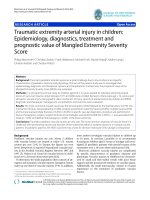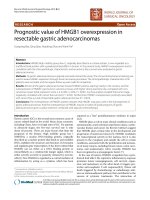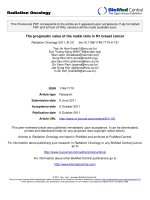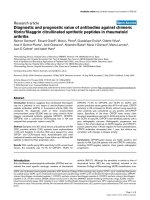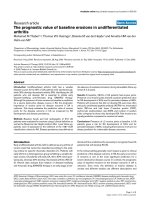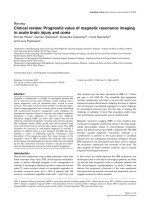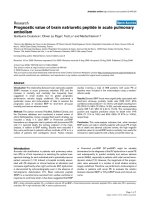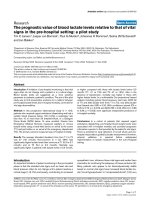Prognostic value of serum free light chain at diagnosis of multiple myeloma
Bạn đang xem bản rút gọn của tài liệu. Xem và tải ngay bản đầy đủ của tài liệu tại đây (968.31 KB, 7 trang )
MEDICAL SCIENCE l ANALYSIS ARTICLE
Medical Science
pISSN 2321–7359; eISSN 2321–7367
Prognostic value of serum free
light chain at diagnosis of
multiple myeloma
Phan Nguyen Thanh Van1*, Cao Thi Loc2
To Cite:
Van PNT, Loc CT. Prognostic value of serum free light chain at diagnosis
of multiple myeloma. Medical Science, 2022, 26, ms192e2292.
doi: />
ABSTRACT
Author affliations
1
Department of Biochemistry, Pham Ngoc Thach University of Medicine,
Ho Chi Minh city, Vietnam
Purposes: To determine the prognostic value of serum free light chain (sFLC) at
Adult Hematology Department no.1, Ho Chi Minh City Hospital of
the diagnosis for patients with multiple myeloma at Ho Chi Minh City
Hematology and Blood Transfusion, Vietnam
Hospital of Hematology and Blood Transfusion. Methods: A retrospective
Corresponding author
study was carried out on 74 patients who were diagnosed with multiple
Department of Biochemistry, Pham Ngoc Thach University of Medicine,
myeloma at Ho Chi Minh City Hospital of Hematology and Blood Transfusion
2
*
Ho Chi Minh City,
Vietnam
from January 2019 to December 2021. Results: Three-year OS of patients in the
Email:
low sFLCR group was higher than that in the high sFLCR group (96.7% vs.
Peer-Review History
74.7%, respectively). Median survival time of patient with low sFLCR was 21.5
Received: 16 May 2022
months while 16.5 months in the high sFLCR group. Three-year PFS of the
Reviewed & Revised: 16/May/2022 to 26/May/2022
Accepted: 26 May 2022
low sFLCR group was higher than that in the high sFLCR group (87.2% vs.
Published: 27 May 2022
64.2%, respectively). The median progression-free survival time in the high
Peer-review Method
sFLCR group and low sFLCR group was 16.5 months and 19 months,
External peer-review was done through double-blind method.
respectively. The difference of OS and PFS among 3 groups NSS1, 2 and 3 was
URL: />
not significant. However, the 3-year PFS among the NSS-1 and NSS-3 groups
was significant when considering each group separately. Conclusion: Serum
free light chain at diagnosis is a good marker to predict the outcomes of
This work is licensed under a Creative Commons Attribution 4.0
myeloma patients.
International License.
Keywords: sFLC, multiple myeloma, OS, PFS
1. INTRODUCTION
Multiple myeloma is a proliferative malignancy of the plasma cells in the bone
marrow, and some other organs, accounting for 1% of all cancers and 10% of
hematologic cancers in particular (Rajkumar et al., 2014; Rajkumar, 2014).
Diagnosis and assessment of disease response were determined based on the
criteria of the International Myeloma Working Group - IMWG (Kyle and
Rajkumar, 2014). The prognosis of multiple myeloma is highly variable due to
the biological heterogeneity of multiple myeloma cells, host factors and bone
marrow microenvironment. Patient prognostic clustering is important, as it
helps to optimize and initiate appropriate treatment to avoid irreversible
organ damage as early as possible. Up to now, the serum-free light chain
(sFLC) measurement test has been developed and widely used in clinical
DISCOVERY
SCIENTIFIC SOCIETY
Copyright © 2022 Discovery Scientific Society.
Medical Science, 26, ms192e2292 (2022)
practice.
In
the
vast
majority
of
patients
with
monoclonal
gammaglobulinemia, plasma cells secrete excess amounts of one of the two
light chains, thereby disrupting the normal ratio between serum κ and λ light
1 of 7
MEDICAL SCIENCE l ANALYSIS ARTICLE
chains. Approximately 15% of patients with plasma cells that secrete only free light chains without any identifiable heavy chains are
referred to as multiple light chain myeloma (DTC) (Rafae et al., 2018).
The IMWG recommends sFLC quantification as part of the standard investigation in diagnosed patients newly with plasmacytic
cytoplasmic disturbances (Dimopoulos et al., 2011) and sFLC is of great importance in the diagnosis of patients with CRC, multiple
myeloma, CRC amyloidosis, and early detection of multiple myeloma nephropathy (Jenner, 2014). Furthermore, the prognostic
value of the serum-free light chain ratio (sFLCR), defined as the ratio of related/unrelated light chain retention at diagnosis and
after treatment, were demonstrated in patients with multiple myeloma. Because of the shorter serum half-life of sFLCs (2-4 hours)
than that of heavy chains (17-21 days), they are valuable as flow markers and sFLC concentration monitoring allows for more
accurate assessment compared with the heavy chain in the assessment of treatment response (Iwama et al., 2013).
More importantly, in multiple myeloma, measurement of sFLC aids in the assessment of treatment response and has been
included in the IMWG recommendation in the strict complete response criteria (sCR), which requires serum sFLCR. Normal bars
add to the complete response criterion without the presence of plasma cells in the bone marrow (Kapoor et al., 2013). Achieving sCR
is associated with improved overall survival and reduced malignant cell load. The puposes of the our study was to determine the
value of serum-free light chain in the prediction of the outcomes of patients who were diagnosed with multiple myeloma.
2. METHODS
We conducted a retrospective study on 74 patients with multiple myeloma who were treated at Ho Chi Minh City Hospital of
Hematology and Blood Transfusion from January 2019 to December 2021. Inclusion criteria were: Adult patients > 18 years old;
Diagnosis of multiple myeloma according to the criteria of IMWG; Be treated according to the regimen with bortezomib at the
hospital; Newly diagnosed and untreated disease. Exclusion criteria were patients who had incomplete medical records (patients
who did not have a quantitative sFLC test at the time of diagnosis).
Treatment protocol
In our study, the majority of patients were treated with a 3-drug regimen of VCD (bortezomib, cyclophosphamide and
dexamethasone). Other regimens include VRD (bortezomib, lenalidomide and dexamethasone), VTD (bortezomib, thalidomide and
dexamethasone), VD (bortezomib and dexamethasone), DTPACE (dexamethasone; thalidomide; cisplatin; doxorubicin;
cyclophosphamide and etoposide) and BRD (bendamustine, lenalidomide and dexamethasone). The treatment response according
to IMWG is shown in Table 1.
Table 1 Treatment response of multiple myeloma according to IMWG
Response classification
Treatment results
Molecular complete remission
Complete remission + ASO-PCR is 10-5
Complete remission + Absence of aberrant phenotypical plasma cell
Strictly Response (sCR)
lines in bone marrow with at least 1 million cells in the marrow as
analyzed by multiparameter flow cytometry (with >4 colors) and
sFLCR normal
All three of the following criteria:
Complete response (CR)
Immunofixation electrophoresis of serum and urine was negative
Loss of plasmacytoma and all soft tissue damage
<5% of plasma cells (in bone marrow).
Either of the following two criteria:
Very good partial response
(VGPR)
Monoclonal protein is also detected on serum and urine IFE, but
negative on blood protein electrophoresis.
Serum M-protein decreased by ≥ 90% and urine M-protein to < 100
mg/24 h.
The following two standards:
Partial response (PR)
Serum M-protein decreased by 50% and
24h urinary M-protein decreased by ≥90% or less than 200mg/24h.
Stable disease (SD)
Does not meet the criteria of CR, VGPR, PR and has no criteria for
advanced disease
Medical Science, 26, ms192e2292 (2022)
2 of 7
MEDICAL SCIENCE l ANALYSIS ARTICLE
At least 1 of the following criteria:
Increase ≥ 25% of initial value:
Progressive disease (PD)
Serum M-protein and/or 0.5g/dl
Used to calculate progression-
Urine M-protein and/or 200 mg/dl
free or progression-free
Bone marrow plasma cells 10%
survival and as an indicator
Record the presence of a new bone lesion or soft tissue
for all patients including those
plasmacytoma, or identify an increase size of previous bone lesion or
with CR
soft tissue plasmacytoma.
Aggravated hypercalcemia is defined by the cause of plasma cell
proliferation alone.
At least 1 of the following criteria:
Direct markers of increased disease and/or target organ damage. Not
used in the calculation of progression-free or progression-free
survival, however, the following markers can be used selectively in
clinical practice.
Clinical recurrence
Development of soft tissue plasmacytoma or new bone lesions.
Identify increased size (≥ 50% of diameters and ≥1 cm) of
plasmacytoma or existing bone lesions.
Hypercalcemia (>2.65 mmol/L).
Decrease Hemoglobin 2 g/dL [1.25 mmol/L]
Increase in serum creatinine 2 mg/dL [from 177 mmol/L]
Recurrence after complete
response
(Only used if the end goal of
the study is DFS)
One of the following criteria:
Re-appearance of M-protein in serum or urine by IFE.
Development of ≥ 5% PC in the bone marrow.
Appearance of other signs of disease progression (new
plasmacytoma, bone lesions, hypercalcemia...)
sFLC testing was performed with whole blood without anticoagulant or with anticoagulant (Heparin). Centrifuge to separate
serum or plasma at 3000 rpm in 10 minutes. Put in NEPH 630_Siemens machine to run according to the process. Reference value:
sFLC κ: 6.7 – 22.4 (mg/L); sFLC λ: 8.3 – 27 (mg/L); sFLC κ/λ: 0.31 -1.56. sFLCR in our study is defined as the light chain ratio κ/λ.
Normal sFLCR values range from 0.26 to 1.65. Outside this range is abnormal sFLCR. Except for one case, when examining the rate
of patients with sFLCR 100 according to the IMWG diagnostic criteria, we used the definition of sFLCR as the ratio between related
light chains to unrelated light chains according to the criteria, recommended by the IMWG. That is, if the patient has a monoclonal
increase in , then sFLCR = κ/λ, whereas if the patient has a monoclonal increase in λ, then sFLCR = λ/κ.
Because sFLCR values are different based on the type of light chain that secretes or, patients with sFLCR values above or below
the median for multiple myeloma and are classified as high sFLCR group or low sFLCR group. Therefore, based on 2 parameters
sFLCR and β2M, the new classification system (NSS) based on high and low sFLCR consists of 3 stages: Stage 1 (NSS-1) is defined
as β2M < 3.5 mg/L and low sFLCR (less than median sFLCR value κ or λ); Stage 2 (NSS-2) when β2M > 3.5 mg/L or high sFLCR
(higher than median sFLCR value κ or λ); Stage 3 (NSS-3) is when β2M > 3.5 mg/L and sFLCR is high.
Data processing with Stata IC 10 software. Use descriptive statistics, univariate analysis and multivariate analysis to control for
confounding factors.
Descriptive statistics
Qualitative variables: use frequency and percentage tables. Use the chi-square test to test for qualitative variables.
Quantitative variables: are represented by two parameters: mean and standard deviation if normally distributed or median
(interquartile range) if the variable has no normal distribution. Pearson's Chi-squared test was used to evaluate the correlation
between sFLCR and patient characteristics, as well as parameters related to multiple myeloma. Kruskal-Wallis test to compare
median sFLCR between different treatment response groups. OS, PFS were calculated by Kaplan Meier method and Log-Rank test.
The different tests have statistical significance when p-value < 0.05.
Medical Science, 26, ms192e2292 (2022)
3 of 7
MEDICAL SCIENCE l ANALYSIS ARTICLE
3. RESULTS
The study followed 74 patients for 3 years. The median OS was 19.5 months, the shortest was 3 months, the longest was 36 months,
8 patients died, and 66 patients were alive. 1-year and 3-year OS are 95% and 85.5% respectively. Same and 1 and 3-year PFS are
89% and 75% respectively. Figure 1 shows 3-year OS in the low sFLCR group and the high group was 96.7% and 74.7%, this
difference was statistically significant with p = 0.03. Median survival in the low sFLCR group was 21.5 months compared with 16.5
months in the high sFLCR group. Figure 2 shows the 3-year PFS of the low sFLCR group and the high sFLCR group was 87.2% and
64.2%, respectively, which were significantly different with p = 0.03, corresponding to the median progression-free survival time,
respectively. in the high sFLCR group was 16.5 months and 19 months compared with the low sFLCR group.
Figure 1 Overall survival between high and low sFLCR groups
Figure 2 Progression-free survival between the low and high sFLCR groups
There was not difference between sFLCR versus different treatment levels across treatment courses (Table 2). Table 3 shows the
new grade system based on sFLCR and β2M. OS difference of 3 groups NSS1, NSS 2 and NSS 3 was not significant (p > 0.05) (Figure
3). The difference in PFS among 3 groups NSS 1, NSS 2 and NSS 3 was not seen (p > 0.05). However, when considering each group
separately, the 3-year PFS between the NSS-1 and NSS-3 groups was statistically significant with p < 0.05 (Figure 4).
Medical Science, 26, ms192e2292 (2022)
4 of 7
MEDICAL SCIENCE l ANALYSIS ARTICLE
Table 2 Differences in sFLCR with treatment response levels across treatment courses
Response
VGPR
PR
SD
PD
p-value
sFLCR 2 courses (n=74)
24
52.5
38
-
0.6
sFLCR 3 or 4 courses (n = 74)
21
88.4
34.1
158
0.25
sFLCR 6 courses (n = 68)
27
96.4
60.7
-
0.23
Treatment course
Table 3 Prognostic value of survival based on the new classification system (NSS)
Group of risk
n
Number of death
3-year OS (%)
Mean OS (month)
NSS-1 (β2M < 3.5 mg/L and low sFLCR)
15
0
100
22.6
NSS-2 (β2M > 3.5 mg/L or high sFLCR)
34
3
89
17.5
NSS-3 (β2M > 3.5 mg/L and sFLCR cao)
25
5
72.5
18
Group of risk
n
Number of event
3-year PFS (%)
Mean PFS (month)
NSS-1 (β2M < 3.5 mg/L and low sFLCR)
15
0
-
21
NSS-2 (β2M > 3.5 mg/L or high sFLCR)
34
7
72.3
16
NSS-3 (β2M > 3.5 mg/L and high sFLCR)
25
7
63.8
17
Figure 3 OS of all patients according to the new classification system
Figure 4 PFS of all patients based on the new classification system.
Medical Science, 26, ms192e2292 (2022)
5 of 7
MEDICAL SCIENCE l ANALYSIS ARTICLE
4. DISCUSSION
According to statistics from previous studies, when comparing sFLC quantification with IFE, serum protein electrophoresis, sFLC
quantification gives more sensitive results in the confirmation of multiple myeloma, with serum quantification and calculation
sFLCR algorithm detected 97.5% and 99.2% (Xu et al., 2013). In our study, all patients had 3 tests, so this role could not be
investigated. According to many previous studies, there are many different cut-offs to classify high and low sFLCR, thereby
assessing the prognosis of patients based on this cut-off. Continuing with previous studies, because our retrospective time was not
long enough, we did not rely on overall survival to determine the cut-off point of sFLCR. An example is that of El Naggar based on
response and non-response to treatment (El Naggar et al., 2015). Other studies based on differences in overall survival and
progression-free time to select the most sensitive and specific cut-off point with a number of cut-off points such as author Snozek et
al., (2008) (sFLCR < 0.03 or >) 32), by Xu et al., (2013) (sFLCR < 0.04, or sFLCR > 25), and more recently by Silva (sFLCR ≥ 47). In
addition, Tacchetii's study is based on different sFLCR milestones (beyond the normal value, it is slightly increased, greater than
100 is elevated) or calculates the median sFLCR, from which that milestone is used to divide the patient group above and below the
median are high and low sFLCR (Kyrtsonis et al., 2007). Because our study period is quite short, we chose to divide according to
author Kyrtsonis et al., (2007) that is, based on the median sFLCR of 2 groups of light chain secretions κ and λ.
The relationship between sFLCR at diagnosis and the outcomes of this diseas has been evaluated in many prior studies.
Kyrtsonis et al., (2007) firstly demonstrated that high sFLCR, defined as related/unrelated, was highly correlated with ISSindependent survival. Specific 5-year survival rates were 82.0% and 30.0%, respectively in patients with associated/unrelated sFLCR
≤ mean. Similarly, in a Mayo Clinic study (Snozek et al., 2008), abnormal sFLCR was an independent prognostic marker. They
concluded that patients with sFLCR < 0.03 or sFLCR > 32 had a worse prognosis with a median survival of 30 months. The authors
suggested that sFLCR could be added to the ISS to improve the risk of multiple myeloma. My study also found the difference of OS,
3-year survival and survival rates of 96.7%, 21.5 months and 74.7%, 16.5 months, respectively in the low sFLCR group compared
with the high sFLCR group (P = 0.0385). PFS and the mean time without disease progression of 3 years were 87.2% and 19 months,
compared with 64.2% and 16.5 months (p = 0.03) in the 2 groups of low and high sFLCR.
5. CONCLUSION
The 3-year OS and PFS of the low sFLCR group and high sFLCR group had statistically significant differences. Similarities between
the two sFLCR groups in terms of post-treatment normality with 3-year OS and 3-year PFS were statistically significantly better
than OS and PFS of the group whose sFLCR did not return to normal after treatment.
Acknowledgement
We thank the participants who were all contributed samples to the study.
Author Contributions
PNTV and CTL contributed equally to this work
Ethical approval
The study was approved by the Medical Ethics Committee of Ho Chi Minh City Hospital of Hematology and Blood Transfusion
(Ethical approval code: 012/HBT)
Funding
This study has not received any external funding.
Conflicts of interest
The authors declare that there are no conflicts of interests.
Data and materials availability
All data associated with this study are present in the paper.
Medical Science, 26, ms192e2292 (2022)
6 of 7
MEDICAL SCIENCE l ANALYSIS ARTICLE
REFERENCES AND NOTES
1. Dimopoulos M, Kyle R, Fermand JP, Rajkumar SV, San
Miguel J, Chanan-Khan A, Ludwig H, Joshua D, Mehta J,
Gertz M, Avet-Loiseau H, Beksac M, Anderson KC, Moreau
P, Singhal S, Goldschmidt H, Boccadoro M, Kumar S, Giralt
S, Munshi NC, Jagannath S Consensus recommendations for
standard investigative workup: report of the International
Myeloma Workshop Consensus Panel 3. Blood 2011;
117(18):4701-4705. 10.1182/blood-2010-10-299529
2. El Naggar AA, El-Naggar M, Mokhamer E-H, Ayad MW
Prognostic value of serum free light chain in multiple
myeloma. Egypt J Immunol 2015; 22(1):00-00.
3. Iwama Ki, Chihara D, Tsuda K, Ugai T, Sugihara H, Nishida
Y, Yamakura M, Takeuchi M, Matsue K Normalization of
free light chain kappa/lambda ratio is a robust prognostic
indicator of favorable outcome in patients with multiple
myeloma. Eur J Haematol 2013; 90(2):134-141.
4. Jenner E Serum free light chains in clinical laboratory
diagnostics.
Clin
Chim
Acta
2014;
42715-20.
/>5. Kapoor P, Kumar SK, Dispenzieri A, Lacy MQ, Buadi F,
Dingli D, Russell SJ, Hayman SR, Witzig TE, Lust JA
Importance of achieving stringent complete response after
autologous stem-cell transplantation in multiple myeloma. J
Clin Oncol 2013; 31(36):4529.
6. Kyle R, Rajkumar SV Erratum: Criteria for diagnosis,
staging, risk stratification and response assessment of
multiple myeloma. Leukemia 2014; 28(4):980.
7. Kyrtsonis MC, Vassilakopoulos TP, Kafasi N, Sachanas S,
Tzenou T, Papadogiannis A, Galanis Z, Kalpadakis C,
Dimou M, Kyriakou E, Angelopoulou MK, Dimopoulou
MN, Siakantaris MP, Dimitriadou EM, Kokoris SI,
Panayiotidis P, Pangalis GA Prognostic value of serum free
light chain ratio at diagnosis in multiple myeloma. Br J
Haematol
2007;
137(3):240-243.
10.1111/j.13652141.2007.06561.x
8. Rafae A, Malik MN, Zar MA, Durer S, Durer C An Overview
of Light Chain Multiple Myeloma: Clinical Characteristics
and Rarities, Management Strategies, and Disease
Monitoring. Cureus 2018; 10(8).
9. Rajkumar SV Multiple myeloma: 2014 Update on diagnosis,
risk‐stratification, and management. Am J Hematol 2014;
89(10):998-1009.
10. Rajkumar SV, Dimopoulos MA, Palumbo A, Blade J, Merlini
G, Mateos MV, Kumar S, Hillengass J, Kastritis E,
Richardson P, Landgren O, Paiva B, Dispenzieri A, Weiss B,
LeLeu X, Zweegman S, Lonial S, Rosinol L, Zamagni E,
Jagannath S, Sezer O, Kristinsson SY, Caers J, Usmani SZ,
Lahuerta JJ, Johnsen HE, Beksac M, Cavo M, Goldschmidt H,
Terpos E, Kyle RA, Anderson KC, Durie BG, Miguel JF
International Myeloma Working Group updated criteria for
the diagnosis of multiple myeloma. Lancet Oncol 2014;
15(12):e538-548. 10.1016/s1470-2045(14)70442-5
Medical Science, 26, ms192e2292 (2022)
11. Snozek CLH, Katzmann JA, Kyle RA, Dispenzieri A, Larson
DR, Therneau TM, Melton LJ, 3rd, Kumar S, Greipp PR,
Clark RJ, Rajkumar SV Prognostic value of the serum free
light chain ratio in newly diagnosed myeloma: proposed
incorporation into the international staging system.
Leukemia 2008; 22(10):1933-1937. 10.1038/leu.2008.171
12. Xu Y, Sui W, Deng S, An G, Wang Y, Xie Z, Yao H, Zhu G,
Zou D, Qi J, Hao M, Zhao Y, Wang J, Chen T, Qiu L Further
stratification of patients with multiple myeloma by
International Staging System in combination with ratio of
serum free κ to λ light chains. Leuk Lymphoma 2013;
54(1):123-132. 10.3109/10428194.2012.704033
7 of 7
